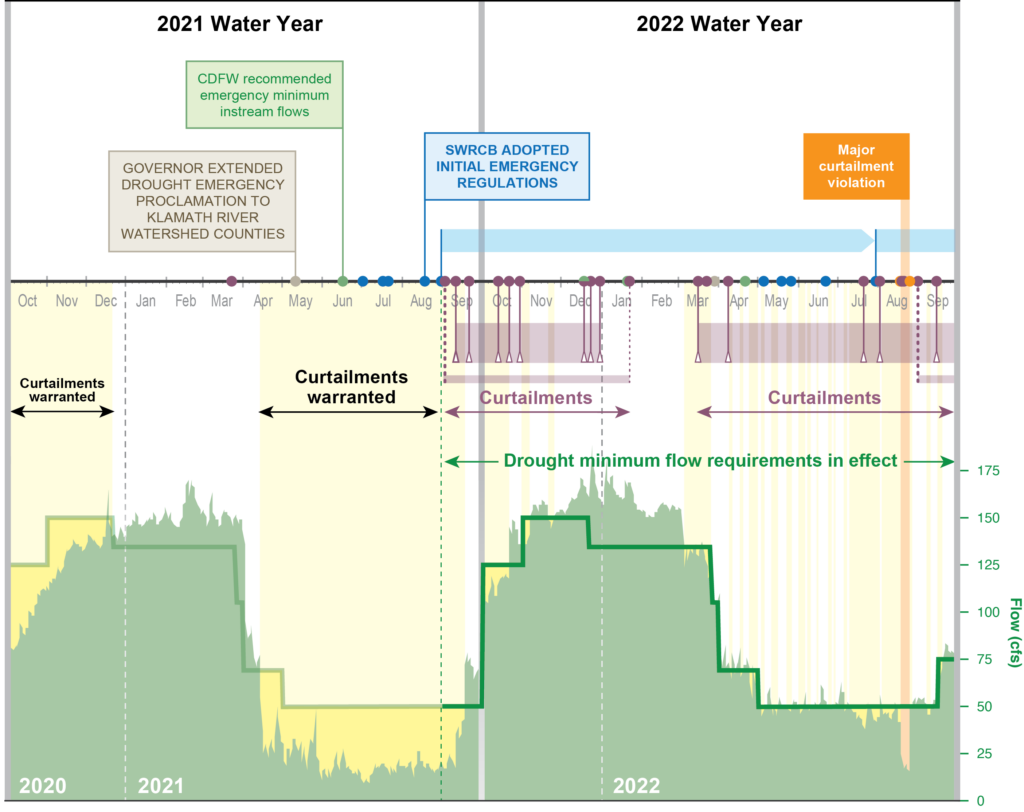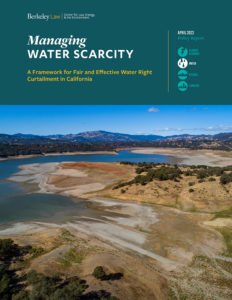To Manage Water Scarcity, California Needs a Framework for Fair and Effective Water Right Curtailment
by Nell Green Nylen, Dave Owen, Jennifer Harder, Michael Kiparsky, and Michael Hanemann
After three years of drought, a parade of storms brought flooding, landslides, and a massive snowpack to California. With water temporarily so abundant, it is tempting to push planning for water scarcity to the back burner. But California does not have this luxury. The state’s water management challenges during wet and dry times interrelate, and are intensifying. Historically, the amount of precipitation that falls in California has been more variable from year-to-year than for any other state. Climate change is exacerbating precipitation variability, supercharging California’s wet and dry extremes and the whiplash between them.
In our new report, Managing Water Scarcity: A Framework for Fair and Effective Water Right Curtailment in California, we argue that the state needs to act now to strengthen its capacity to fairly and effectively allocate water in times of scarcity. The report
- describes the legal context for water right curtailments in California,
- summarizes the history of curtailment practices in the state, and
- recommends actions California can take to build an effective framework for curtailment.
Key takeaways
1. Curtailments are fundamental to effective drought response. When there is not enough water to satisfy all demands, water must be allocated among competing human and environmental uses. California’s State Water Resources Control Board (SWRCB) needs to be able to routinely require diverters to curtail (stop) unlawful water uses in order to protect water rights, human health and safety, and the environment from serious harm.
2. The State has rarely implemented curtailments. As we detailed in a pair of 2018 reports, the SWRCB has implemented curtailments only rarely, in certain watersheds, during certain major statewide droughts, using different approaches each time. Our new report finds improvements during the recent drought. But it also identifies serious ongoing failings, driven largely by resource constraints, an inadequate statutory toolset, and an emergency-based approach to curtailment.
3. The SWRCB’s current approach to curtailment is its most advanced and effective yet, but has important limitations. The SWRCB is currently using watershed-based emergency regulations under Water Code section 1058.5 as its primary tool for implementing curtailments. However, this authority is not always available when curtailments are needed. Ironically, this includes when water shortage develops quickly. The authority is only available in the 3rd year of a drought or after the Governor proclaims a drought emergency. Yet, if water shortage develops quickly, the SWRCB needs to be able to implement timely curtailments to prevent irreparable harm to water right holders, communities, and environmental resources. This is not just a theoretical problem. In 2021—the second year of a statewide drought—the SWRCB had to wait for the Governor to declare a drought emergency for a particular watershed before it undertook a months-long process to develop and implement emergency curtailment regulations for that watershed. As a result, the SWRCB issued curtailment orders months after they were warranted. The figure below shows an example from the Shasta River watershed.
4. Current enforcement options are wholly inadequate. Most enforcement mechanisms take weeks, or longer, to implement, and the magnitude of available penalties can be insufficient to deter violations. For example, in August 2022, a group of water users diverted more than half of the Shasta River’s flow, in direct violation of a curtailment order, for more than a week. This major curtailment violation is shown in the figure below. Although the SWRCB instructed them to immediately turn off their pumps, the agency lacked the authority to physically shut the diversion down. The SWRCB imposed the maximum penalty for this violation: $4,000, or about $50 per water user within the violating group. This penalty was much less than the value of the water illegally diverted, and it did nothing to redress the irreparable harm the violation inflicted on sensitive fisheries and more-senior water users in the watershed.
5. California needs routine curtailments. The state needs to implement curtailments on a regular basis, not only in times of extreme crisis or only in certain watersheds. For part of every year, water demand exceeds supply in some watersheds in California. The SWRCB needs to be able to implement curtailments whenever and wherever that imbalance occurs.
6. Routine curtailments happen in other western states. California cannot afford to continue to be an outlier.

Recommendations
We offer a framework for action to help California manage water scarcity. The framework includes some elements the SWRCB can implement on its own. It also includes recommendations for swift and decisive legislative action. The SWRCB has broad responsibility and general authority to implement curtailments under the California Constitution’s requirement for reasonable use, the state public trust doctrine, and aspects of California’s Water Code. It also has access to some specific tools it can use to implement curtailments. However, clarifying and solidifying the SWRCB’s authorities in statute and upgrading its statutory tool set to better reflect the agency’s critical role in managing water scarcity may be crucial for enabling effective curtailments in the future.
At a high level:
- The SWRCB can establish a basic framework for curtailments through non-emergency rulemaking.
- The Legislature can take actions to update the SWRCB’s statutory toolset for implementing curtailments. These actions include enabling more effective curtailment regulations and enhancing curtailment enforcement options.
- The SWRCB can take actions, with legislative support, to improve engagement and information for fair and effective curtailments.
Together, these actions will help the SWRCB meet one of its most basic and important responsibilities: implementing water right curtailments during times of water shortage. The actions will begin to close the increasingly untenable gaps between legal requirements and on-the-ground practice.
It may seem ironic that California needs to take action on water scarcity during one of the wettest times in state history. Nevertheless, at stake is the state’s ability to protect the water rights of more-senior diverters, maintain instream flows needed to support water quality and environmental water uses, and reliably ensure that water is available to meet the basic human health and safety needs of California communities.
Download the executive summary for a more complete overview.
Download the full report to see our detailed analysis and recommendations.
This work was funded by the State Water Resources Control Board (Agreement Number 19-067-300), with additional support from Agriculture and Food Research Initiative Competitive Grant no. 2021-69012-35916 from the USDA National Institute of Food and Agriculture via the Secure Water Future project. It builds on a pair of 2018 reports in which we examined how the State Water Resources Control Board carried out its water rights responsibilities during past droughts and offered recommendations for improving the agency’s future drought response capabilities.
Nell recapped our 2018 work in a Legal Planet series you can explore here:
- Part 1: Why It’s Important to Prepare for Drought During a Deluge
- Part 2: Water Rights Administration and Oversight During Past California Droughts
- Part 3: Actions to Improve California Water Rights Administration and Oversight for Future Droughts
- Part 4: A Contingency-Based Framework to Support Drought Decision Making
- Part 5: Developing a Decision-Support Framework for Curtailment
- Part 6: Making Key Policy Decisions in Advance of Droughts
Reader Comments
One Reply to “To Manage Water Scarcity, California Needs a Framework for Fair and Effective Water Right Curtailment”
Comments are closed.







** Please note, this message is NOT for publication, rather an inquiry. Again, please don’t post, this is a request for information. **
Hello LegalPlanet,
Felice Pace shared information about you. I have not heard of your activities before. Given that CA received abundant rainfall and snow during the winter of 2022-2023, I believe that at this time there should be NO water curtailments! Who you know if there are any curtailments now?
I, like Felice, am concerned about the Klamath River (in particular), because the WILD spring and fall salmon are “gone” in my opinion. As I understand, water from the Trinity River (which flows into the Klamath River) is being diverted (and has for years by 3 particular vocal agricultural women). How can this diversion be stopped?
It seems that the CA WRCB is a “god” that can’t be controlled, but is of ultimate authority; not accountable to anybody. How can this government nightmare be required to be transparent and held responsible?
Thank you, looking forward to hearing from you.